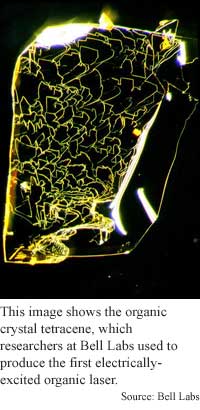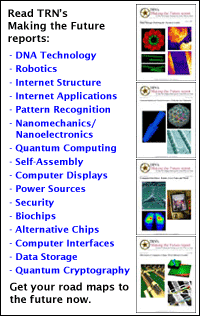
Cheaper lasers on the way
By Kimberly Patch, Technology Research NewsEditor's note: this research has been withdrawn by the scientists.
Researchers at Bell Labs have taken a big step toward cheaper, more flexible lasers.
Traditionally, small electrical lasers, which guide powerful beams of light for a wide variety of uses including CD players, surgical devices and telecommunications equipment, have been made of ceramic materials like those used in computer chips.
For years, scientists have been looking for a way to replace the ceramics with organic materials, because there are more to choose from, they are potentially more flexible and cheaper to manufacture then inorganic ceramics. Until now, however, scientists have only been able to make organic materials lase, or emit a beam of light whose waves are lined up, by using a ceramic-based laser as the light source.
Bell Labs researchers, however, have constructed a electrically-powered organic laser by using field effect transistors (FET's) to apply voltage to an organic tetracene crystal in a way that made it emit a yellowish-green laser pulse.
The keys to making the organic laser were the purity of the tetracene crystal, and the use of FETs, said J. Hendrik Schön, a researcher at Lucent Technologies' Bell Labs.
The tetracene crystal absorbs very little light, allowing most of the emitted light to pass through it. In addition, few defects in the material means electrical charges will pass through cleanly as well. "If you want to achieve laser action, if the light [emitted] is absorbed in the material itself, it is a bad thing," said Schön. To avoid this, the crystal "has a very low intrinsic absorption in this wavelength region where we have the stimulated emissions. [In addition] we don't have defects which are scattering the [electrical charge]. So the high quality of these crystals is important both optically and electrically," he said.
The FETs allow for fine control of the electrical current that sets off the light emission in the crystal. "We use field effect electrodes to [electrify the crystal] and by doing so we [were able] to balance the positive and negative charge carriers very carefully... This is an advantage compared to conventional device structures," said Schön.
"It's a very clever device and it is in an area that currently we don't have great understanding about," said Stephen Forrest, professor of electrical engineering at Princeton University. It's an important first step in understanding electrically pumped organic lasers, he said. Eventually, the device "could lead to organic lasers that are used for a lot of different applications from wavelength standards to light sources in laser scanners."
Organic lasers will likely be important because with more materials to choose from, they have the potential to emit light at many different frequencies, or colors. In addition, organic materials are potentially cheaper to manufacture then ceramics. "Compared to conventional inorganic semiconductors we use rather low temperatures [and] we don't use any ultrahigh vacuum systems, said Schön.
It will be at least several years before commercial grade organic lasers could be produced, said Schön. "There are many steps which have to be made in order to make practical devices," he said.
First, they will try to find better crystals, Schön said. They will also tune the emissions wavelengths to get different colors, and they need to make the lasers mirrors more reflective in order to achieve laser action at lower electrical currents, he said. Another step is to "grow high-quality thin films to make different devices on... flexible plastic substrates," he added.
Organic lasers eventual usefulness will depend on "how much power they put out, how long they live [and] what colors are available. Reliability issues are extremely important," said Forrest.
Schön's colleagues in the research were Ananth Dodabalapur, Bertram Batlogg and Christian Kloc. The research was funded by Lucent Technologies.
Timeline: > 3 years
Funding: Corporate
TRN Categories: Semiconductors and Materials; Optical Computing, Optoelectronics and Photonics
Story Type: News
Related Elements: Photo, Technical paper "An Organic Solid State Injection Laser," in Science, July 28, 2000
Advertisements:
September 13, 2000
Page One
Cheap lasers on the way
Nanotubes make microscopic bearings
Integrated inputs improve interactivity
Microorganisms infect computer chips
Sandia brews cheap telecom laser

News:
Research News Roundup
Research Watch blog
Features:
View from the High Ground Q&A
How It Works
RSS Feeds:
News
Ad links:
Buy an ad link
| Advertisements:
|
 |
Ad links: Clear History
Buy an ad link
|
TRN
Newswire and Headline Feeds for Web sites
|
© Copyright Technology Research News, LLC 2000-2006. All rights reserved.